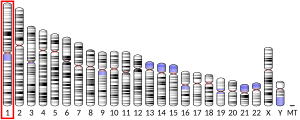SPRR1A
Izgled
Kornifin-A jest protein koji je kod ljudi kodiran genom SPRR1A sa hromosoma 1.[5][6]
Aminokiselinska sekvenca
[uredi | uredi izvor]Dužina polipeptidnog lanca je 89 aminokiselina, a molekulska težina 9.877 Da.[7]
| 10 | 20 | 30 | 40 | 50 | ||||
|---|---|---|---|---|---|---|---|---|
| MNSQQQKQPC | TPPPQPQQQQ | VKQPCQPPPQ | EPCIPKTKEP | CHPKVPEPCH | ||||
| PKVPEPCQPK | VPEPCQPKVP | EPCPSTVTPA | PAQQKTKQK |
Reference
[uredi | uredi izvor]- ^ a b c GRCh38: Ensembl release 89: ENSG00000169474 - Ensembl, maj 2017
- ^ a b c GRCm38: Ensembl release 89: ENSMUSG00000050359 - Ensembl, maj 2017
- ^ "Human PubMed Reference:". National Center for Biotechnology Information, U.S. National Library of Medicine.
- ^ "Mouse PubMed Reference:". National Center for Biotechnology Information, U.S. National Library of Medicine.
- ^ Gibbs S, Fijneman R, Wiegant J, van Kessel AG, van De Putte P, Backendorf C (juni 1993). "Molecular characterization and evolution of the SPRR family of keratinocyte differentiation markers encoding small proline-rich proteins". Genomics. 16 (3): 630–7. doi:10.1006/geno.1993.1240. PMID 8325635.
- ^ "Entrez Gene: SPRR1A small proline-rich protein 1A".
- ^ "UniProt, P35321" (jezik: engleski). Pristupljeno 19. 12. 2021.
Dopunska literatura
[uredi | uredi izvor]- Greco MA, Lorand L, Lane WS, Baden HP, Parameswaran KN, Kvedar JC (februar 1995). "The pancornulins: a group of small proline rich-related cornified envelope precursors with bifunctional capabilities in isopeptide bond formation". The Journal of Investigative Dermatology. 104 (2): 204–10. doi:10.1111/1523-1747.ep12612759. PMID 7829876.
- Robinson PA, Marley JJ, High AS, Hume WJ (mart 1994). "Differential expression of protease inhibitor and small proline-rich protein genes between normal human oral tissue and odontogenic keratocysts". Archives of Oral Biology. 39 (3): 251–9. doi:10.1016/0003-9969(94)90051-5. PMID 8018055.
- Fujimoto W, Nakanishi G, Arata J, Jetten AM (februar 1997). "Differential expression of human cornifin alpha and beta in squamous differentiating epithelial tissues and several skin lesions". The Journal of Investigative Dermatology. 108 (2): 200–4. doi:10.1111/1523-1747.ep12334240. PMID 9008234.
- Robinson NA, Lapic S, Welter JF, Eckert RL (maj 1997). "S100A11, S100A10, annexin I, desmosomal proteins, small proline-rich proteins, plasminogen activator inhibitor-2, and involucrin are components of the cornified envelope of cultured human epidermal keratinocytes". The Journal of Biological Chemistry. 272 (18): 12035–46. doi:10.1074/jbc.272.18.12035. PMID 9115270.
- Reddy SP, Konkin T, Wu R (decembar 1998). "Structure and organization of the genes encoding mouse small proline-rich proteins, mSPRR1A and 1B". Gene. 224 (1–2): 59–66. doi:10.1016/S0378-1119(98)00507-1. PMID 9931436.
- Candi E, Tarcsa E, Idler WW, Kartasova T, Marekov LN, Steinert PM (mart 1999). "Transglutaminase cross-linking properties of the small proline-rich 1 family of cornified cell envelope proteins. Integration with loricrin". The Journal of Biological Chemistry. 274 (11): 7226–37. doi:10.1074/jbc.274.11.7226. PMID 10066784.
- Lee CH, Marekov LN, Kim S, Brahim JS, Park MH, Steinert PM (juli 2000). "Small proline-rich protein 1 is the major component of the cell envelope of normal human oral keratinocytes". FEBS Letters. 477 (3): 268–72. doi:10.1016/S0014-5793(00)01806-8. PMID 10908733.
- Hartley JL, Temple GF, Brasch MA (novembar 2000). "DNA cloning using in vitro site-specific recombination". Genome Research. 10 (11): 1788–95. doi:10.1101/gr.143000. PMC 310948. PMID 11076863.
- Cabral A, Voskamp P, Cleton-Jansen AM, South A, Nizetic D, Backendorf C (juni 2001). "Structural organization and regulation of the small proline-rich family of cornified envelope precursors suggest a role in adaptive barrier function". The Journal of Biological Chemistry. 276 (22): 19231–7. doi:10.1074/jbc.M100336200. PMID 11279051.
- Bonilla IE, Tanabe K, Strittmatter SM (februar 2002). "Small proline-rich repeat protein 1A is expressed by axotomized neurons and promotes axonal outgrowth". The Journal of Neuroscience. 22 (4): 1303–15. doi:10.1523/JNEUROSCI.22-04-01303.2002. PMC 6757578. PMID 11850458.





